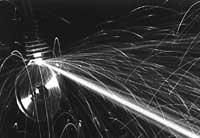Soft magnetic materials, Magnetoelastic and Magnetoresistent
1999/02/01 Plazaola, Fernando Iturria: Elhuyar aldizkaria
Magnetic materials (MM) can be classified into two large sections: SOFT MM and HARD MM in sections. Soft MM can be magnetized in very weak magnetic fields (obtaining magnet properties), but they are easily demagnetized (once removed the field that has magnetized them lose their magnet properties). These materials are used in electromagnets, motors, generators, transformers and other devices that often need to magnetize and demagnetize (sometimes 50 times per second). To be able to magnetize the hard MM it is necessary to apply violent fields, but once magnetized, although the outer field is removed, the properties of the magnet continue to become permanent magnets.
Our team has investigated in the last 15 years soft MM, amorphous MM and nanocrystals with extreme properties. To obtain these materials we use cooling speeds.The disordered atoms in liquid state (about 1000 °C) we make them pass to solid state in thousandths of a second so that they do not have time to order (see figure). These materials are metal atoms like Fe, Ni and/or Co and B, Si, P... They are formed by a mixture of "metaloids".

By "being so disordered" they have no privileged direction for "magnetization", not even at atomic level. Therefore, although the magnetic field applied is very weak, the induced magnetization will be directed towards the direction of the field. In this situation, very vulnerable areas are able to fully magnetize these materials. These fields can represent up to one hundred of the Earth's magnetic field. (It is very weak but orients its "influences" compass and small magnets that may be in some bacteria, doves or rocks).
The magnetic field applied in soft MM is not the only magnitude that influences magnetization, in some cases mechanical stresses can be decisive in the magnetization of these materials. This effect is called MAGNETOELASTICITY. In some amorphous MM, especially in those with the highest number of Faith, the sensitivity to magnetization voltage can vary by 1,000 or 10,000 factors (keeping the outer field fixed). This enormous sensitivity is very appropriate for the construction of sensors of different types (i.e., force sensors, strain, vibration, etc. ), as well as for other more "sophisticated" applications, such as magnetic detection of distant objects, in which we have been working for years.
The other general property of magnetic materials is the variation of the electrical resistivity associated with the magnetization process, MR. In most MM this variation is very small (<2%), but some materials (compounds intercalated by the magnetic layer with non-magnetic layers and formed by small magnetic grains immersed in non-magnetic materials) present a giant MR (~ 50%). Also, recently materials (oxides of La and Mn) have been found that present variations of resistance to certain temperatures in some magnate orders. Such spectacular resistance changes (1,000%-10,000%) are called colossal MR and will be very applicable in the near future to sensors. Our team has just begun the investigation of these materials and their applications, such as “sensing position without contact” in the suspension of cars.
- Title of the project: Soft magnetic materials, Magnetoelastic and Magnetoresistents.
- Objective:: Objective: 1) Investigation of the relationship between structure and properties in the aforementioned materials. 2) Improvement of the aforementioned materials. 3) Design and testing of sensors based on the aforementioned materials.
- Financing: Financing: Basque Government, CYCIT, UPV
- Director: J. M. M. Barandiaran Barandiaran
- Research team: F. F. Plazaola, S.L. Fdez-Gubieda, J. Gutierrez, J.S. Garitaonandia, G. Kurlandiskaya, J.L. Muñoz Muñoz
- Department: Department of Electricity and Electronics.
- Center: Center: Faculty of Sciences.

Gai honi buruzko eduki gehiago
Elhuyarrek garatutako teknologia




